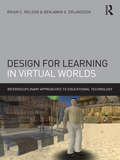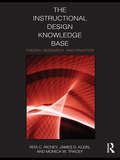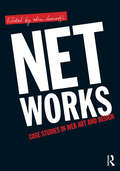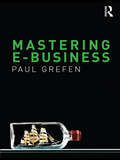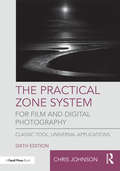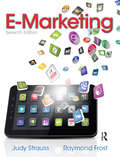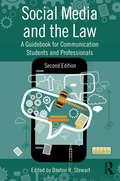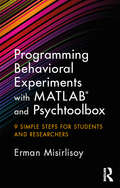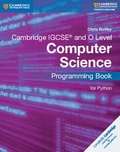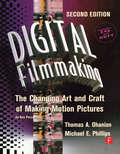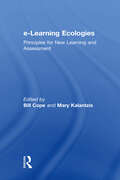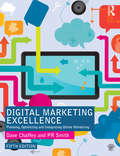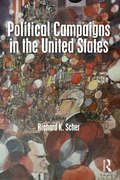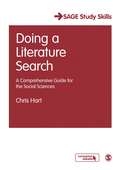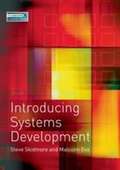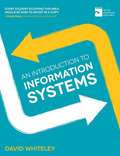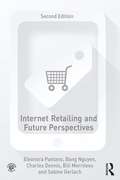- Table View
- List View
Design for Learning in Virtual Worlds
by Brian C. Nelson Benjamin E. ErlandsonDesign for Learning in Virtual Worlds, the first book focused specifically on how to design virtual worlds for educational purposes, explores: • the history and evolution of virtual worlds • the theories behind the use of virtual worlds for learning • the design of curricula in virtual worlds • design guidelines for elements experienced in virtual worlds that support learning • design guidelines for learning quests and activities in virtual worlds. The authors also examine the theories and associated design principles used to create embedded assessments in virtual worlds. Finally, a framework and methodology is provided to assist professionals in evaluating "off-the-shelf" virtual worlds for use in educational and training settings. Design for Learning in Virtual Worlds will be invaluable both as a professional resource and as a textbook for courses within Educational Technology, Learning Sciences, and Library Media programs that focus on gaming or online learning environments.
Design for Learning in Virtual Worlds
by Brian C. Nelson Benjamin E. ErlandsonDesign for Learning in Virtual Worlds, the first book focused specifically on how to design virtual worlds for educational purposes, explores: • the history and evolution of virtual worlds • the theories behind the use of virtual worlds for learning • the design of curricula in virtual worlds • design guidelines for elements experienced in virtual worlds that support learning • design guidelines for learning quests and activities in virtual worlds. The authors also examine the theories and associated design principles used to create embedded assessments in virtual worlds. Finally, a framework and methodology is provided to assist professionals in evaluating "off-the-shelf" virtual worlds for use in educational and training settings. Design for Learning in Virtual Worlds will be invaluable both as a professional resource and as a textbook for courses within Educational Technology, Learning Sciences, and Library Media programs that focus on gaming or online learning environments.
The Instructional Design Knowledge Base: Theory, Research, and Practice
by Rita C. Richey James D. Klein Monica W. TraceyThe Instructional Design Knowledge Base: Theory, Research and Practice provides ID professionals and students at all levels with a comprehensive exploration of the theories and research that serve as a foundation for current and emerging ID practice. This book offers both current and classic interpretations of theory from a range of disciplines and approaches. It encompasses general systems, communication, learning, early instructional, media, conditions-based, constructivist design and performance-improvement theories. Features include: rich representations of the ID literature concise theory summaries specific examples of how theory is applied to practice recommendations for future research a glossary of related terms a comprehensive list of references. A perfect resource for instructional design and technology doctoral, masters and educational specialist certificate programs, The Instructional Design Knowledge Base provides students and scholars with a comprehensive background for ID practice and a foundation for future ID thinking.
The Instructional Design Knowledge Base: Theory, Research, and Practice
by Rita C. Richey James D. Klein Monica W. TraceyThe Instructional Design Knowledge Base: Theory, Research and Practice provides ID professionals and students at all levels with a comprehensive exploration of the theories and research that serve as a foundation for current and emerging ID practice. This book offers both current and classic interpretations of theory from a range of disciplines and approaches. It encompasses general systems, communication, learning, early instructional, media, conditions-based, constructivist design and performance-improvement theories. Features include: rich representations of the ID literature concise theory summaries specific examples of how theory is applied to practice recommendations for future research a glossary of related terms a comprehensive list of references. A perfect resource for instructional design and technology doctoral, masters and educational specialist certificate programs, The Instructional Design Knowledge Base provides students and scholars with a comprehensive background for ID practice and a foundation for future ID thinking.
Net Works: Case Studies in Web Art and Design
by Xtine BurroughNet Works offers an inside look into the process of successfully developing thoughtful, innovative digital media. In many practice-based art texts and classrooms, technology is divorced from the socio-political concerns of those using it. Although there are many resources for media theorists, practice-based students sometimes find it difficult to engage with a text that fails to relate theoretical concerns to the act of creating. Net Works strives to fill that gap. Using websites as case studies, each chapter introduces a different style of web project--from formalist play to social activism to data visualization--and then includes the artists' or entrepreneurs' reflections on the particular challenges and outcomes of developing that web project. Scholarly introductions to each section apply a theoretical frame for the projects. A companion website offers further resources for hands-on learning. Combining practical skills for web authoring with critical perspectives on the web, Net Works is ideal for courses in new media design, art, communication, critical studies, media and technology, or popular digital/internet culture.
Net Works: Case Studies in Web Art and Design
by Xtine BurroughNet Works offers an inside look into the process of successfully developing thoughtful, innovative digital media. In many practice-based art texts and classrooms, technology is divorced from the socio-political concerns of those using it. Although there are many resources for media theorists, practice-based students sometimes find it difficult to engage with a text that fails to relate theoretical concerns to the act of creating. Net Works strives to fill that gap. Using websites as case studies, each chapter introduces a different style of web project--from formalist play to social activism to data visualization--and then includes the artists' or entrepreneurs' reflections on the particular challenges and outcomes of developing that web project. Scholarly introductions to each section apply a theoretical frame for the projects. A companion website offers further resources for hands-on learning. Combining practical skills for web authoring with critical perspectives on the web, Net Works is ideal for courses in new media design, art, communication, critical studies, media and technology, or popular digital/internet culture.
Mastering e-Business
by Paul Grefene-Business – business collaborations enabled through information and communication technologies – is an essential activity for any business organization and constitutes a significant and growing sector. This textbook presents an innovative teaching framework to help students gain a thorough understanding of the principles of this vital aspect of business and management. Casting aside the over-complicated and narrow introductions of other textbooks, Grefen presents, analyzes and explains the principles of e-Business with refreshing clarity. The book covers both the business and technology aspects of this topic, using a unique framework integrating: Business – focuses on why a specific e-Business scenario exists and how an organization can profit from it Organization – analyzes how organizations and their processes are structured to achieve strategic goals Architecture – explains the high level design of advanced information systems to describe how e-Business functions Technology – examines the technological implementation of e-Business scenarios using a wide variety of ingredients from IT Mastering e-Business offers a well-structured overview of all aspects of e-Business and is an essential read for all students and professionals interested in this central aspect of modern, global business.
Mastering e-Business
by Paul Grefene-Business – business collaborations enabled through information and communication technologies – is an essential activity for any business organization and constitutes a significant and growing sector. This textbook presents an innovative teaching framework to help students gain a thorough understanding of the principles of this vital aspect of business and management. Casting aside the over-complicated and narrow introductions of other textbooks, Grefen presents, analyzes and explains the principles of e-Business with refreshing clarity. The book covers both the business and technology aspects of this topic, using a unique framework integrating: Business – focuses on why a specific e-Business scenario exists and how an organization can profit from it Organization – analyzes how organizations and their processes are structured to achieve strategic goals Architecture – explains the high level design of advanced information systems to describe how e-Business functions Technology – examines the technological implementation of e-Business scenarios using a wide variety of ingredients from IT Mastering e-Business offers a well-structured overview of all aspects of e-Business and is an essential read for all students and professionals interested in this central aspect of modern, global business.
The Practical Zone System for Film and Digital Photography: Classic Tool, Universal Applications
by Chris JohnsonThis sixth edition of The Practical Zone System by Chris Johnson updates the classic manual on Ansel Adams's landmark technique for the digital age. For photographers working digitally or with film, in color or black and white, in the studio or on the go, this simple visual language helps to control contrast and, through a process called Previsualization, provides photographers with the power of free creative expression. This new edition discusses recent advances in technology and potentials for their use in zone photography, including HDR, smartphone cameras that shoot in raw format and smartphone light meters. Johnson demonstrates how the Zone System is a universal visual and conceptual language that dramatically simplifies the problem of creating and rendering complex lighting setups.
E-marketing
by Judy Strauss Raymond D. FrostFor courses in Internet Marketing or E-marketing This book teaches marketers how to engage and listen to buyers, and how to use what they learn to improve their offerings in today’s Internet- and social media-driven marketing environment. It brings traditional marketing coverage up-to-date with a thorough, incisive look at e-marketing planning and marketing mix tactics from a strategic and tactical perspective. The focus is on the Internet and other technologies that have had a profound effect on how marketing is approached today. Included is coverage of marketing planning; legal and global environments; e-marketing strategy; and marketing mix and customer relationship management strategy and implementation issues. A major revision, this seventh edition reflects the disruption to the marketing field brought about by social media. As such it covers many new topics that represent the changes in e-marketing practice in the past two years. Because of the ever-changing landscape of the Internet, the authors suggest reading this book, studying the material, and then going online to learn more about topics of interest. Features: Better understanding of new concepts in today’s electronic marketplace is accomplished as the book puts that new terminology into traditional marketing frameworks. Readers are encouraged to exercise critical thinking and attention to their own online behavior in order to better understanding the e-marketer’s perspective, strategies, and tactics–to think like a marketer. Although the focus is on e-marketing in the United States, readers also see a global perspective in the coverage of market developments in both emerging and developed nations. An entire chapter devoted to law and ethics, and contributed by a practicing attorney, updates readers on the latest changes in this critical area. Readers are guided in learning a number of e-marketing concepts with the help of some outstanding pedagogical features:-Marketing concept grounding helps readers make the connection between tradition and today. Material in each chapter is structured around a principle of marketing framework, followed by a look at how the internet has changed the structure or practice, providing an ideal bridge from previously learned material.-Learning objectives set the pace and the goals for the material in each chapter.-Best practices from real companies tell success stories, including new examples of firms doing it right.-Graphical frameworks serve as unique e-marketing visual models illustrating how each chapter fits among others.-Chapter summaries help readers review and refresh the material covered.-Key terms are identified in bold text within the chapter to alert readers to their importance.-Review and discussion questions are another device to be used for refreshing readers’ understanding of the material in the chapter.-Web activities at the end of each chapter help readers become further involved in the content.-This revision reflects the disruption to the marketing field based on social media. A major revision from the sixth edition, it includes many new topics, as dictated by changes in e-marketing practice in the past two years.-Three important Appendices include internet adoption statistics, a thorough glossary, and book references. NEW. Students get a broader look at social media as it is now integrated throughout the book, instead of confined to one chapter. NEW. A look a new business models continues and strengthens the approach of learning from real life examples. Added and described in detail are such models as social commerce (and Facebook commerce), mobile commerce and mobile marketing, social CRM, crowsourcing, and many important be less pervasive models such as crowfunding, freemium, and flash sales. NEW.Chapters 12, 13 and 14 were completely rewritten to reflect the move from traditional marketing communication tools to the way practitioners current describe IMC online: owned, paid and earned media. NEW. Readers see examples of many new and interesting technologies that are today providing marketing opportunities
E-marketing
by Judy Strauss Raymond D. FrostFor courses in Internet Marketing or E-marketing This book teaches marketers how to engage and listen to buyers, and how to use what they learn to improve their offerings in today’s Internet- and social media-driven marketing environment. It brings traditional marketing coverage up-to-date with a thorough, incisive look at e-marketing planning and marketing mix tactics from a strategic and tactical perspective. The focus is on the Internet and other technologies that have had a profound effect on how marketing is approached today. Included is coverage of marketing planning; legal and global environments; e-marketing strategy; and marketing mix and customer relationship management strategy and implementation issues. A major revision, this seventh edition reflects the disruption to the marketing field brought about by social media. As such it covers many new topics that represent the changes in e-marketing practice in the past two years. Because of the ever-changing landscape of the Internet, the authors suggest reading this book, studying the material, and then going online to learn more about topics of interest. Features: Better understanding of new concepts in today’s electronic marketplace is accomplished as the book puts that new terminology into traditional marketing frameworks. Readers are encouraged to exercise critical thinking and attention to their own online behavior in order to better understanding the e-marketer’s perspective, strategies, and tactics–to think like a marketer. Although the focus is on e-marketing in the United States, readers also see a global perspective in the coverage of market developments in both emerging and developed nations. An entire chapter devoted to law and ethics, and contributed by a practicing attorney, updates readers on the latest changes in this critical area. Readers are guided in learning a number of e-marketing concepts with the help of some outstanding pedagogical features:-Marketing concept grounding helps readers make the connection between tradition and today. Material in each chapter is structured around a principle of marketing framework, followed by a look at how the internet has changed the structure or practice, providing an ideal bridge from previously learned material.-Learning objectives set the pace and the goals for the material in each chapter.-Best practices from real companies tell success stories, including new examples of firms doing it right.-Graphical frameworks serve as unique e-marketing visual models illustrating how each chapter fits among others.-Chapter summaries help readers review and refresh the material covered.-Key terms are identified in bold text within the chapter to alert readers to their importance.-Review and discussion questions are another device to be used for refreshing readers’ understanding of the material in the chapter.-Web activities at the end of each chapter help readers become further involved in the content.-This revision reflects the disruption to the marketing field based on social media. A major revision from the sixth edition, it includes many new topics, as dictated by changes in e-marketing practice in the past two years.-Three important Appendices include internet adoption statistics, a thorough glossary, and book references. NEW. Students get a broader look at social media as it is now integrated throughout the book, instead of confined to one chapter. NEW. A look a new business models continues and strengthens the approach of learning from real life examples. Added and described in detail are such models as social commerce (and Facebook commerce), mobile commerce and mobile marketing, social CRM, crowsourcing, and many important be less pervasive models such as crowfunding, freemium, and flash sales. NEW.Chapters 12, 13 and 14 were completely rewritten to reflect the move from traditional marketing communication tools to the way practitioners current describe IMC online: owned, paid and earned media. NEW. Readers see examples of many new and interesting technologies that are today providing marketing opportunities
Social Media and the Law: A Guidebook for Communication Students and Professionals
by Daxton StewartSocial media platforms like Facebook, Twitter, Instagram, YouTube, and Snapchat allow users to connect with one another and share information with the click of a mouse or a tap on a touchscreen—and have become vital tools for professionals in the news and strategic communication fields. But as rapidly as these services have grown in popularity, their legal ramifications aren’t widely understood. To what extent do communicators put themselves at risk for defamation and privacy lawsuits when they use these tools, and what rights do communicators have when other users talk about them on social networks? How can an entity maintain control of intellectual property issues—such as posting copyrighted videos and photographs—consistent with the developing law in this area? How and when can journalists and publicists use these tools to do their jobs without endangering their employers or clients? Including two new chapters that examine First Amendment issues and ownership of social media accounts and content,?Social Media and the Law brings together thirteen media law scholars to address these questions and more, including current issues like copyright, online impersonation, anonymity, cyberbullying, sexting, and live streaming. Students and professional communicators alike need to be aware of laws relating to defamation, privacy, intellectual property, and government regulation—and this guidebook is here to help them navigate the tricky legal terrain of social media.
Social Media and the Law: A Guidebook for Communication Students and Professionals
by Daxton StewartSocial media platforms like Facebook, Twitter, Instagram, YouTube, and Snapchat allow users to connect with one another and share information with the click of a mouse or a tap on a touchscreen—and have become vital tools for professionals in the news and strategic communication fields. But as rapidly as these services have grown in popularity, their legal ramifications aren’t widely understood. To what extent do communicators put themselves at risk for defamation and privacy lawsuits when they use these tools, and what rights do communicators have when other users talk about them on social networks? How can an entity maintain control of intellectual property issues—such as posting copyrighted videos and photographs—consistent with the developing law in this area? How and when can journalists and publicists use these tools to do their jobs without endangering their employers or clients? Including two new chapters that examine First Amendment issues and ownership of social media accounts and content,?Social Media and the Law brings together thirteen media law scholars to address these questions and more, including current issues like copyright, online impersonation, anonymity, cyberbullying, sexting, and live streaming. Students and professional communicators alike need to be aware of laws relating to defamation, privacy, intellectual property, and government regulation—and this guidebook is here to help them navigate the tricky legal terrain of social media.
Programming Behavioral Experiments with MATLAB and Psychtoolbox: 9 Simple Steps for Students and Researchers
by Erman MisirlisoyHuman behavior is fascinating so it’s no surprise that psychologists and neuroscientists spend their lives designing rigorous experiments to understand it. MATLAB is one of the most widely used pieces of software for designing and running behavioral experiments, and it opens up a world of quick and flexible experiment programming. This book offers a step-by-step guide to using MATLAB with Psychtoolbox to create customisable experiments. Its pocket size and simple language allow you to get straight to the point and help you to learn fast in order to complete your work in great time. In nine simple steps, it guides you all the way from setting parameters for your experiment to analysing the output. Gone are the daunting days of working through hundreds of irrelevant and complicated documents, as in this handy book, Erman Misirlisoy coaxes you in the right direction with his friendly and encouraging tricks and tips. If you want to learn how to develop your own experiments to collect and analyse behavioral data, then this book is a must-read. Whether you are a student in experimental psychology, a researcher in cognitive neuroscience, or simply someone who wants to run behavioral tasks on your friends for fun, this book will offer you the skills to succeed.
Cambridge IGCSE® and O Level Computer Science Programming Book for Python (Cambridge International IGCSE) (PDF)
by Chris RoffeyThis resource is written to follow the updated IGSCE Computer Science syllabus 0478 with examination from June and November 2016. Cambridge IGCSE and O Level Computer Science Programming Book for Python accompanies the Cambridge IGCSE and O Level Computer Science coursebook, and is suitable for students and teachers wishing to use Python in their studies. It introduces and develops practical skills to guide students in developing coding solutions to the tasks presented in the book. Starting from simple skills and progressing to more complex challenges, this book shows how to approach a coding problem using Structure Diagrams and Flow Charts, explains programming logic using pseudocode, develops Python programming skills and gives full solutions to the tasks set.
Digital Filmmaking: The Changing Art And Craft Of Making Motion Pictures
by Thomas A. Ohanian Michael E. Phillips Natalie Phillips-HamblettDigital Filmmaking has been called the bible for professional filmmakers in the digital age. It details all of the procedural, creative, and technical aspects of pre-production, production, and post-production within a digital filmmaking environment. It examines the new digital methods and techniques that are redefining the filmmaking process, and how the evolution into digital filmmaking can be used to achieve greater creative flexibility as well as cost and time savings. The second edition includes updates and new information, including four new chapters that examine key topics like digital television and high definition television,making films using digital video, 24 P and universal mastering, and digital film projection. Digital Filmmaking provides a clear overview of the traditional filmmaking process, then goes on to illuminate the ways in which new methods can accomplish old tasks. It explains vital concepts, including digitization, compression, digital compositing, nonlinear editing, and on-set digital production and relates traditional film production and editing processes to those of digital techniques. Various filmmakers discuss their use of digital techniques to enhance the creative process in the "Industry Viewpoints" sections in each chapter .
e-Learning Ecologies: Principles for New Learning and Assessment
by Bill Cope Mary Kalantzise-Learning Ecologies explores transformations in the patterns of pedagogy that accompany e-learning—the use of computing devices that mediate or supplement the relationships between learners and teachers—to present and assess learnable content, to provide spaces where students do their work, and to mediate peer-to-peer interactions. Written by the members of the "new learning" research group, this textbook suggests that e-learning ecologies may play a key part in shifting the systems of modern education, even as technology itself is pedagogically neutral. The chapters in this book aim to create an analytical framework with which to differentiate those aspects of educational technology that reproduce old pedagogical relations from those that are genuinely innovative and generative of new kinds of learning. Featuring case studies from elementary schools, colleges, and universities on the practicalities of new learning environments, e-Learning Ecologies elucidates the role of new technologies of knowledge representation and communication in bringing about change to educational institutions.
Digital Marketing Excellence: Planning, Optimizing and Integrating Online Marketing
by Dave Chaffey Pr SmithNow in its fifth edition, the hugely popular Digital Marketing Excellence: Planning, Optimizing and Integrating Online Marketing is fully updated, keeping you in line with the changes in this dynamic and exciting field and helping you create effective and up-to-date customer-centric digital marketing plans. A practical guide to creating and executing digital marketing plans, it combines established approaches to marketing planning with the creative use of new digital models and digital tools. It is designed to support both marketers and digital marketers, and students of business or marketing who want a thorough yet practical grounding in digital marketing. Written by two highly experienced digital marketing consultants, the book shows you how to: Draw up an outline digital marketing plan Evaluate and apply digital marketing principles and models Integrate online and offline communications Implement customer-driven digital marketing Reduce costly trial and error Measure and enhance your digital marketing Learn best practices for reaching and engaging your audiences using the key digital marketing platforms like Apple, Facebook, Google and Twitter. This new edition seamlessly integrates the latest changes in social media technology, including expanded coverage of mobile technology, demonstrating how these new ways to reach customers can be integrated into your marketing plans. It also includes new sections on data analytics, clearly demonstrating how marketers can leverage data to their advantage. Offering a highly structured and accessible guide to a critical and far-reaching subject, Digital Marketing Excellence, Fifth Edition, provides a vital reference point for all students and managers involved in marketing strategy and implementation.
Digital Marketing Excellence: Planning, Optimizing and Integrating Online Marketing
by Dave Chaffey Pr SmithNow in its fifth edition, the hugely popular Digital Marketing Excellence: Planning, Optimizing and Integrating Online Marketing is fully updated, keeping you in line with the changes in this dynamic and exciting field and helping you create effective and up-to-date customer-centric digital marketing plans. A practical guide to creating and executing digital marketing plans, it combines established approaches to marketing planning with the creative use of new digital models and digital tools. It is designed to support both marketers and digital marketers, and students of business or marketing who want a thorough yet practical grounding in digital marketing. Written by two highly experienced digital marketing consultants, the book shows you how to: Draw up an outline digital marketing plan Evaluate and apply digital marketing principles and models Integrate online and offline communications Implement customer-driven digital marketing Reduce costly trial and error Measure and enhance your digital marketing Learn best practices for reaching and engaging your audiences using the key digital marketing platforms like Apple, Facebook, Google and Twitter. This new edition seamlessly integrates the latest changes in social media technology, including expanded coverage of mobile technology, demonstrating how these new ways to reach customers can be integrated into your marketing plans. It also includes new sections on data analytics, clearly demonstrating how marketers can leverage data to their advantage. Offering a highly structured and accessible guide to a critical and far-reaching subject, Digital Marketing Excellence, Fifth Edition, provides a vital reference point for all students and managers involved in marketing strategy and implementation.
Political Campaigns in the United States
by Richard K. ScherA Choice Highly Recommended Title—January 2017 This book is an interpretive analysis of political campaigns in America: instead of focusing on how campaigns are designed and run, it investigates the role campaigns play in our American politics, and the close symbiosis between campaigns and those politics. The text examines how campaigns are an important manifestation of how we "do" politics in this country. Hallmarks of this text include: showing how campaigns can undermine our democracy and asking how democratic they—and by extension, our politics--really are; demonstrating that the ability of the media to accurately, fairly, and deeply report on campaigns has been severely compromised, both because of the growing "distance" between campaigns and media outlets and because of the structure of "Big Media" corporate ownership and its tight relationship to "Big Money." It asks important questions about the media including: How do the media, reporters in particular, cover campaigns? What pressures and forces shape what and how they present campaigns? What is the impact of the ever-increasing chasm separating campaigns and the media? How does the close tie between corporate mainstream media and Super PAC money affect campaign coverage? How does the ability of campaigns and media to segment voters into ever-smaller slices influence how campaigns are covered? tracking the continuing growth of unregulated, private, unaccountable "dark money" in campaigns as a threat to our democratic elections and politics. Democracy rests fundamentally on transparency and accountability – sunlight – and our campaign laws and norms now allow and encourage exactly the opposite, largely because of decisions by the United States Supreme Court.
Airline e-Commerce: Log on. Take off.
by Michael HankeFrom the few tickets that were sold by Alaska Airlines and former British Midland in December 1995 via the industry’s first airline booking engine websites, global online travel has grown to generate today more than half a trillion dollars in annual revenue. This development has brought significant changes to the airline business, travel markets, and consumers. Today, airlines worldwide not only use e-commerce for online marketing and selling but also as a platform to offer unique services and capabilities that have no counterpart in the physical world. This book is an in-depth introduction to airline e-commerce. It covers a broad scope of areas that are essential to an airline’s ongoing digital transformation. Digital properties & features E-marketing E-sales & distribution Web customer service E-commerce organization E-commerce strategy Written by an airline e-commerce expert and illustrated with numerous examples of leading airlines in this area, Dr. Hanke provides for comprehensive "behind-the-scenes" details of how airline e-commerce works. This book is a crucial companion for students and practitioners alike because it allows the reader to acquire a thorough foundation of airline e-commerce. Furthermore, the book enables the reader to appreciate the ramifications of airline e-commerce in certain corporate areas and to take effective action for a successful e-commerce strategy.
Doing A Literature Search: A Comprehensive Guide For The Social Sciences (PDF)
by Christopher HartDoing a Literature Searchprovides a practical and comprehensive guide to searching the literature on any topic within the social sciences. The book will enable the reader to search the literature effectively, identifying useful books, articles, statistics and many other sources of information. The text will be an invaluable research tool for postgraduates and researchers across the social sciences.
Introducing Systems Development (PDF)
by Steve Skidmore Malcolm EvaIntroducing Systems Development offers a concise introduction to systems analysis and design, suitable for undergraduates on Computer Science or Business Studies programs. Based on Steve Skidmore's previous two books, Introducing Systems Analysis and Introducing Systems Design, this comprehensive text retains the strong practical emphasis that characterised these texts. Key features include: extensive coverage of object-oriented methods and UML, coverage of more traditional structured techniques, end-of-chapter exercises and a developing case study. Extra resources are available online.
An Introduction To Information Systems: Organisations, Applications, Technology, And Design (PDF)
by David WhiteleyA clear, student-friendly and engaging introduction to how information technology is used in business. Featuring several case studies, video interviews, thorough pedagogy and completely up-to-date chapters, this textbook will be a core resource for undergraduate students of Business Information Systems, a compulsory module in business degrees.
Internet Retailing and Future Perspectives
by Eleonora Pantano Bang Nguyen Charles Dennis Sabine GerlachSince the first edition of this landmark textbook, online shopping has grown exponentially to the point that it now threatens to eclipse the high street. With online retail offering both advantages and challenges that are distinct from traditional commerce, this textbook provides new approaches to retailing and as such helps readers to take advantage of new digital technologies. This long-awaited new edition provides a thorough and substantial update to its solid core principle of digital retailing and its relationship with conventional retail methods. These principles are explained clearly and practically to provide students, entrepreneurs and researchers with a reliable guide to the implementation and operation of a successful online retailing business. Updates to this edition include: Search engine marketing and search engine optimization. New and updated case studies, including Tesco’s virtual store, Ray-Ban’s smart mirror, IKEA’s mobile catalogue and Nordstrom’s TextStyle. Social networks and electronic word-of-mouth communication. A new chapter on ubiquitous retailing. A brand new companion website to support tutors. With accessibly written features such as key learning points, questions, think points and further reading, Internet Retailing and Future Perspectives is ideal for anyone using, studying or researching digital commerce.
